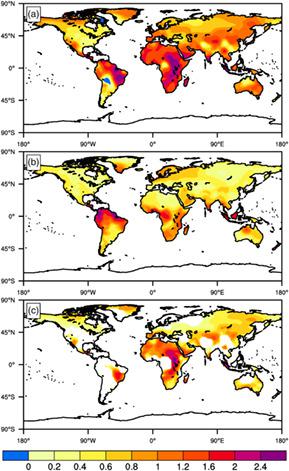当前位置:
X-MOL 学术
›
Int. J. Climatol.
›
论文详情
Our official English website, www.x-mol.net, welcomes your
feedback! (Note: you will need to create a separate account there.)
Unnatural trend of global land long‐term surface air temperature change
International Journal of Climatology ( IF 3.5 ) Pub Date : 2020-12-05 , DOI: 10.1002/joc.6961 Yu Wang 1, 2 , Pengcheng Yan 3 , Fei Ji 1 , Shankai Tang 1 , Liu Yang 1 , Shujuan Hu 1 , Guolin Feng 1, 4, 5
International Journal of Climatology ( IF 3.5 ) Pub Date : 2020-12-05 , DOI: 10.1002/joc.6961 Yu Wang 1, 2 , Pengcheng Yan 3 , Fei Ji 1 , Shankai Tang 1 , Liu Yang 1 , Shujuan Hu 1 , Guolin Feng 1, 4, 5
Affiliation

|
In the context of global warming, determining to what extent natural variability and external forcing have an impact on climate change is crucial for formulating mitigation policies and adaptation plans. We quantifiably and effectively separate unnatural trends from the global land surface air temperature (SAT) changes during 1951–2015 by calculating the long‐term correlation exponent through detrended fluctuation analysis and applying mainly probability statistics methods. We provide effective discriminated evidence for whether the observed SAT change exceeds its natural internal variability. Furthermore, we search the range of SAT changes caused by unnatural trends, and identify their corresponding minimum contributions to warming relative trends in different regions. The unnatural warming of the mid‐ to high latitude inland areas of Eurasia and North America is basically high, and the warming responses to unnatural forcing are most intense in these areas. Compared to earlier detection, we find the minimum unnatural trend contributes more than 80% to the observed SAT change in North America, northern Greenland, eastern Africa, and the mid‐ to high latitudes of Eurasia. In addition, the temporal evolutions of unnatural trends in key areas are determined. In North Africa, Western Australia, the United States and Mexico, the unnatural impact became significant at the earliest. Meanwhile, the overall unnatural trend in North Africa is the most significant, followed by western Brazil, and grows most rapidly over time in the two key areas.
中文翻译:

全球土地长期地表气温变化的不自然趋势
在全球变暖的背景下,确定自然变异和外部强迫在多大程度上影响气候变化对于制定缓解政策和适应计划至关重要。我们通过反趋势波动分析并主要采用概率统计方法计算长期相关指数,从而定量有效地将1951–2015年的非自然趋势与全球陆地表面气温(SAT)变化区分开。对于观察到的SAT变化是否超过其自然内部可变性,我们提供了有效的区分证据。此外,我们搜索由非自然趋势引起的SAT变化范围,并确定它们对不同地区变暖相对趋势的相应最小贡献。欧亚大陆和北美洲中高纬度内陆地区的自然变暖基本上很高,在这些地区,对自然变暖的变暖反应最为强烈。与早期发现相比,我们发现在北美洲,格陵兰北部,东部非洲以及中高纬度的欧亚大陆,观测到的SAT变化最小的自然趋势超过了80%。此外,还确定了关键地区非自然趋势的时间演变。在北非,西澳大利亚州,美国和墨西哥,这种不自然的影响最早在早期就变得很重要。同时,北非的总体非自然趋势最为显着,其次是巴西西部,并且在两个关键地区随时间增长最快。这些地区对非自然强迫的变暖反应最为强烈。与早期发现相比,我们发现在北美洲,格陵兰北部,东部非洲以及中高纬度的欧亚大陆,观测到的SAT变化最小的自然趋势超过了80%。此外,还确定了关键地区非自然趋势的时间演变。在北非,西澳大利亚州,美国和墨西哥,这种不自然的影响最早在早期就变得很重要。同时,北非的总体非自然趋势最为显着,其次是巴西西部,并且在两个关键地区随时间增长最快。这些地区对非自然强迫的变暖反应最为强烈。与早期发现相比,我们发现在北美洲,格陵兰北部,东部非洲以及中高纬度的欧亚大陆,观测到的SAT变化最小的自然趋势超过了80%。此外,还确定了关键地区非自然趋势的时间演变。在北非,西澳大利亚州,美国和墨西哥,这种不自然的影响最早在早期就变得很重要。同时,北非的总体非自然趋势最为显着,其次是巴西西部,并且在两个关键地区随时间增长最快。东非以及欧亚大陆的中高纬度地区。此外,还确定了关键地区非自然趋势的时间演变。在北非,西澳大利亚州,美国和墨西哥,这种不自然的影响最早在早期就变得很重要。同时,北非的总体非自然趋势最为显着,其次是巴西西部,并且在两个关键地区随时间增长最快。东非以及欧亚大陆的中高纬度地区。此外,还确定了关键地区非自然趋势的时间演变。在北非,西澳大利亚州,美国和墨西哥,这种不自然的影响最早在早期就变得很重要。同时,北非的总体非自然趋势最为显着,其次是巴西西部,并且在两个关键地区随时间增长最快。
更新日期:2020-12-05
中文翻译:

全球土地长期地表气温变化的不自然趋势
在全球变暖的背景下,确定自然变异和外部强迫在多大程度上影响气候变化对于制定缓解政策和适应计划至关重要。我们通过反趋势波动分析并主要采用概率统计方法计算长期相关指数,从而定量有效地将1951–2015年的非自然趋势与全球陆地表面气温(SAT)变化区分开。对于观察到的SAT变化是否超过其自然内部可变性,我们提供了有效的区分证据。此外,我们搜索由非自然趋势引起的SAT变化范围,并确定它们对不同地区变暖相对趋势的相应最小贡献。欧亚大陆和北美洲中高纬度内陆地区的自然变暖基本上很高,在这些地区,对自然变暖的变暖反应最为强烈。与早期发现相比,我们发现在北美洲,格陵兰北部,东部非洲以及中高纬度的欧亚大陆,观测到的SAT变化最小的自然趋势超过了80%。此外,还确定了关键地区非自然趋势的时间演变。在北非,西澳大利亚州,美国和墨西哥,这种不自然的影响最早在早期就变得很重要。同时,北非的总体非自然趋势最为显着,其次是巴西西部,并且在两个关键地区随时间增长最快。这些地区对非自然强迫的变暖反应最为强烈。与早期发现相比,我们发现在北美洲,格陵兰北部,东部非洲以及中高纬度的欧亚大陆,观测到的SAT变化最小的自然趋势超过了80%。此外,还确定了关键地区非自然趋势的时间演变。在北非,西澳大利亚州,美国和墨西哥,这种不自然的影响最早在早期就变得很重要。同时,北非的总体非自然趋势最为显着,其次是巴西西部,并且在两个关键地区随时间增长最快。这些地区对非自然强迫的变暖反应最为强烈。与早期发现相比,我们发现在北美洲,格陵兰北部,东部非洲以及中高纬度的欧亚大陆,观测到的SAT变化最小的自然趋势超过了80%。此外,还确定了关键地区非自然趋势的时间演变。在北非,西澳大利亚州,美国和墨西哥,这种不自然的影响最早在早期就变得很重要。同时,北非的总体非自然趋势最为显着,其次是巴西西部,并且在两个关键地区随时间增长最快。东非以及欧亚大陆的中高纬度地区。此外,还确定了关键地区非自然趋势的时间演变。在北非,西澳大利亚州,美国和墨西哥,这种不自然的影响最早在早期就变得很重要。同时,北非的总体非自然趋势最为显着,其次是巴西西部,并且在两个关键地区随时间增长最快。东非以及欧亚大陆的中高纬度地区。此外,还确定了关键地区非自然趋势的时间演变。在北非,西澳大利亚州,美国和墨西哥,这种不自然的影响最早在早期就变得很重要。同时,北非的总体非自然趋势最为显着,其次是巴西西部,并且在两个关键地区随时间增长最快。











































 京公网安备 11010802027423号
京公网安备 11010802027423号